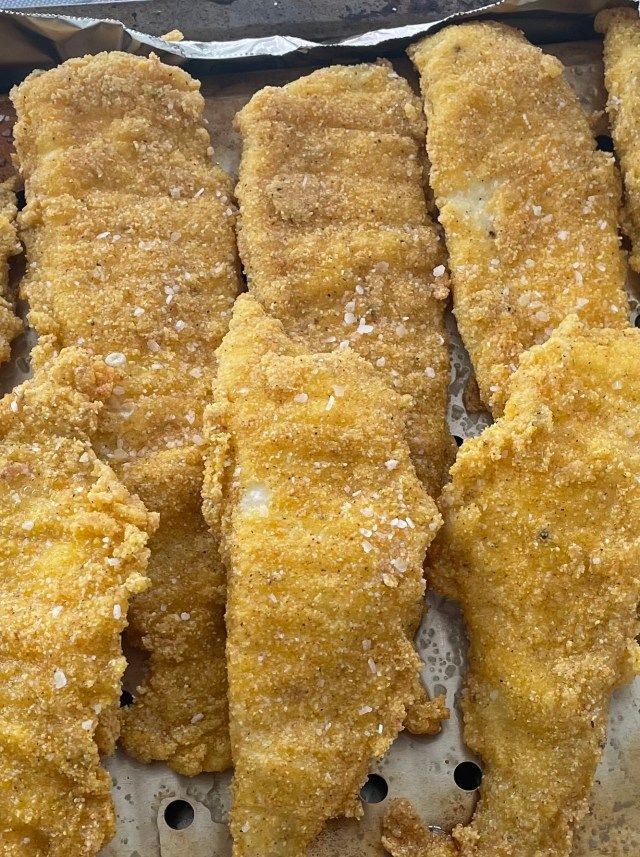Fried Flounder

I’ve been making fried flounder for my family for at least 15 years now. The recipes have stayed mostly the same but I have made some changes recently that have drastically improved the outcome.
Some of the improvements I’ve made have been based on reading that I have done and some basic cooking techniques that I learned. Some of these things may seem like common sense to professional cooks, but it didn’t settle in for me until I seen it firsthand. Here are some rules that I am following. These rules are applicable to other recipes as well (such as fried chicken).
1. The meat (in this case fish) should be dried thoroughly. Since I am frying this fish, I want it to stay firm in the pan, not fall-apart, steam, or become mushy.
2. I used a full dredge (flour, egg, and breading). Some of the seasonings for the fried fish say to only put a little water on the fish for the seasoning to adhere and don’t mention dredging. If you are short on time, this is ok but the little bit of water may cause the oil to splatter a little bit and also cause the flounder to steam (and get mushy). If you have some time and want a firmer, crispier fish, I’d say that you should take the time and do the full dredge.
3. I set my stovetop on medium low and gradually letting the temperature of the oil climb. In regards to the temp setting, the idea is if I have enough time, I like to let the temperature of the oil slowly climb to desired temp. I used the 3 setting on my stovetop. By gradually heating up the oil, I feel it is easier to control and I don’t risk having to adjust the heat up and down as I’m cooking. Typically, as I’m cooking a lot of fish or chicken, the pieces at the end of cooking tend to get darker and cook to a different consistency. This time, the cooking was more even and I did not have to adjust the the temp even though I cooked the large batch of fish for about 30 minutes or so.
4. To check temp of oil, I drop some of the breading in the oil and look for a little bit of a sizzle and bubbling around the breading. It shouldn’t be a loud sizzle or too low of a sizzle. Bubbles should quickly form around the breading but you should not hear any loud crackles. Once you get to this point it is good to put the fish in.
5. I let the breaded fish sit on a raised pan while I was breading the rest of the fish and heating the oil. This helped get rid of any excess moisture and also helps the breading settle in.
6. Don’t overcrowd the meat in the pan. I only put about 4 pieces of fish in the 12 inch skillet. Each piece of fish was about 1.5 to 2 inches wide. You don’t want to lower the temp of the oil too much and don’t want to steam the fish and breading.
7. The fish or other type of meat being used should not have a bad smell.
Ingredients
2 Pounds of Flounder (deboned)
2 Eggs
Approximately 1 Cup of Flour
Salt/Pepper
Your Favorite Seafood Breading (I use Louisiana Style)
Peanut Oil (See below)
Technique
I Used frozen flounder (Nature’s Promise). Maybe 1/4 inch thick. It was thawed under ice water. The most appropriate way is to do it over ice in the refrigerator.
1. Cut bones from middle of fish.
2. Dry both sides of fish with paper towels so the meat would not steam and get mushy.
3. Use 3 containers. Put approximately 1 cup of flour (with salt/pepper) in first container. In the second container, mix 2 eggs (with salt/pepper), and use your favorite breading in the third container.
4. With one hand, apply the flour to a piece of fish. Follow with dipping in egg mixture with other hand. Lastly, apply breading with the same hand that was used for flour. The idea is to use one hand for dry-mixing and the other hand for wet mixing.
5. Transfer fish to raised pan (rack with cookie sheet) to let breading dry a little bit while I breaded up rest of fish and heated oil.
6. Put oil in pan over medium-low heat. I only put enough oil in the pan to cover the fish half way. This is a very shallow fry. In a 12 inch skillet, I put approximately 4 pieces of fish. Each piece of fish was approximately 1.5 to 2 inches wide.
7. Cook each side for about 2 minutes. Since this is a very thin fish (around 1/4 inch). The breading should be golden and set. The fish should be a little flaky on the outside, firm (in the middle), and opaque white (all the way through). Adjust this time if the fish is thicker.
The breading should be set and be golden and also want the inside of the fish to be done.
8, Let sit on raised pan for a few minutes and season with salt as desired.
Some other Tips
1. If the breading gets too dark before the fish is done, the temp may be too high.
2. On the other hand, if the fish is greasy and breading is soggy, the oil wasn’t hot enough.